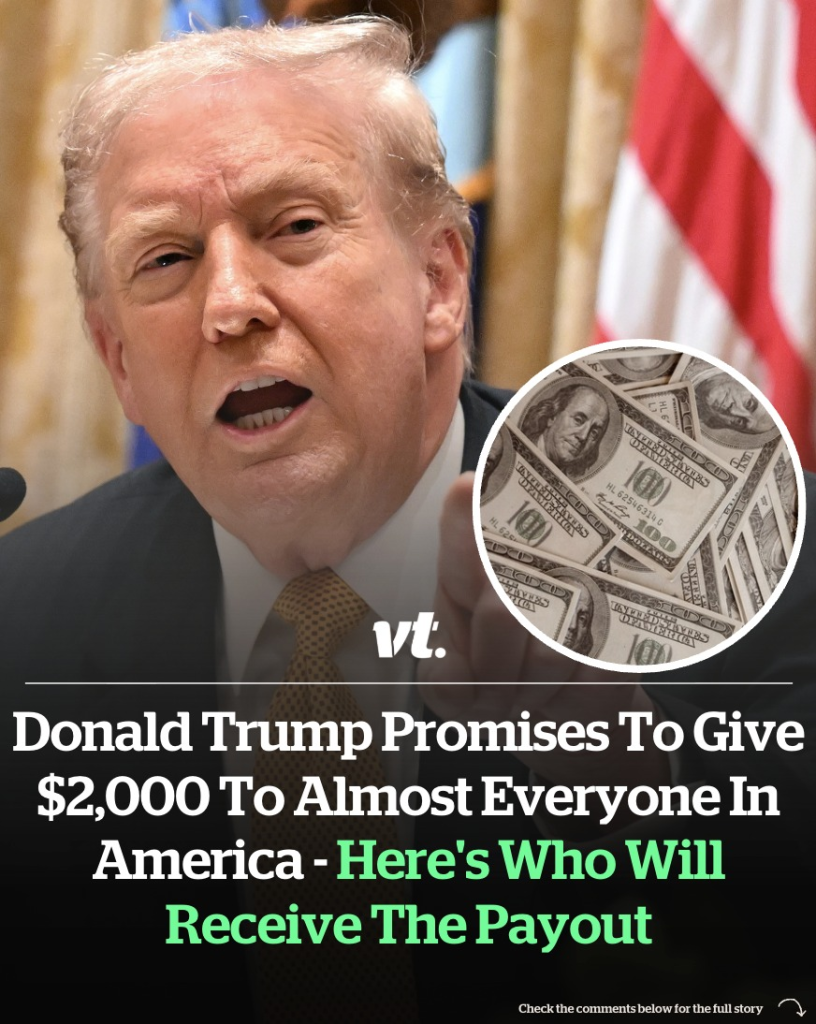It started with a quiet murmur online—an unusual post on Truth Social that quickly spiraled into speculation.
Donald Trump had promised $2,000 to nearly every American, but the details were hazy. No timeline, no eligibility rules, and no clear funding plan. Observers couldn’t help but wonder: was this a genuine economic proposal, or a carefully timed stunt designed to grab headlines and sway opinion?
The more analysts dug, the murkier it became. Behind the promise of cash lay a tangle of tariffs, legal challenges, and questions about feasibility—raising suspicions that the announcement might be more about spectacle than substance.

Donald Trump made waves in the news on Monday morning with a flurry of posts on Truth Social, linking his broad tariff agenda to a bold promise: “A dividend of at least $2,000 per person (excluding high-income earners) will be paid to everyone.”
Details remain vague, however, as the posts included no clear timeline, income thresholds, or eligibility criteria, according to the Independent.
This isn’t the first time Trump has floated the idea. Earlier in July and October, he suggested similar rebate-style checks tied to tariff revenues. But now, as tariff receipts rise and legal scrutiny intensifies, he appears to be doubling down on the proposal.
Tariffs as the Funding Engine
Trump presented the plan as a win-win: tariffs generate revenue, stimulate domestic investment, and provide Americans with a cash bonus. On Truth Social, he wrote:
“People that are against Tariffs are FOOLS! We are now the Richest, Most Respected Country In the World, With Almost No Inflation, and A Record Stock Market Price. 401k’s are Highest EVER.”
He also claimed:
“We are taking in Trillions of Dollars and will soon begin paying down our ENORMOUS DEBT, $37 Trillion. Record Investment in the USA, plants and factories going up all over the place.”
Trump envisions a system funded largely through tariffs on global imports—the same trade tool currently under legal challenge. He argued that while the U.S. can halt all trade with foreign countries in certain circumstances, it supposedly cannot impose tariffs for national security purposes. Trump framed tariffs as key to attracting businesses to the U.S., questioning why courts appear to challenge their use.
Practical Hurdles to the $2,000 Payout
Analysts warn that while the idea is appealing, two major obstacles exist: cost and legality. Depending on eligibility and whether children are included, estimates suggest the payouts could range from $300 billion to $513 billion.
Economist Erica York noted that if the cutoff is set at $100,000, roughly 150 million adults would qualify, totaling about $300 billion. By comparison, tariffs have generated only $90 billion in net revenue so far. Arnold Ventures’ co-chair estimated costs could reach $513 billion.
Even though the U.S. collected approximately $195 billion in customs duties during the first three quarters of 2025, that still falls short of covering the proposed payouts.
Legal Challenges
The proposal also depends on tariffs that are currently being contested in court. The Supreme Court recently heard cases challenging the president’s use of emergency powers under the International Emergency Economic Powers Act (IEEPA) to impose sweeping tariffs. Lower courts have already ruled the method illegal, raising questions about the viability of the revenue stream for the $2,000 payouts.
Unanswered Questions
Trump’s three-part strategy—tariff revenue, direct payouts, and messaging about economic strength—leaves several key details undefined:
Who qualifies: “high income” limits are unspecified.
Timing: no schedule or mechanism for distribution is provided.
Legal and financial feasibility: tariffs under challenge may not generate the needed revenue.
In short, while the promise of $2,000 per person has grabbed headlines, analysts caution that Americans should not expect the checks to arrive anytime soon.
Conclusion:
In the end, Trump’s $2,000 payout pledge illustrates the fine line between political promise and practical reality. While the idea of a direct dividend is enticing, the combination of vague eligibility criteria, uncertain timing, and tariffs facing court scrutiny makes its execution highly unlikely.
For now, it remains a headline-grabbing statement—a reminder that even bold claims require careful scrutiny before they translate into tangible results for the American public.
